THE CIVILIAN CONSERVATION
CORPS
An organization of
the Civilian Conservation Corps, directed as it is toward the accomplishment of
very useful conservation of forest and land resources, has an additional and
equally important responsibility—the conservation and development of human
resources. W. Frank Persons is Director of the United States Employment Service,
Washington, D.C. He has served as the Representative of the Department of Labor
on the Advisory Council for Emergency Conservation Work since the beginning of
the enterprise in 1933.
Early in May 1933,
there was opportunity to present to the Director of the Corps and his Advisory
Council a memorandum that recognized the responsibility of conservation of
forest and land resources. The following paragraphs are of a statement made by
W. Frank Persons.
"These
young men (CCC enrollees) come from the ranks of those who have been almost
universally deprived of the American Citizen’s normal right—the chance for
self-support and self-development. They represent that great number of American
youth who have arrived at working age and found absolutely no opportunity for
employment. These young men are heart sick and disappointed."
"The
Conservation Program should include provision for the conservation of the morale
of the rising generation. An investment made in that purpose will only
strengthen the success of the whole enterprise. It will be well worth while for
its own sake."
"It
is the fundamental purpose of the plan here suggested to prepare the young men
who are seeking this avenue of escape from unemployment, to be better fitted to
enter permanent occupations upon their return from forestry camps, and better
qualified to hold such employment as they do secure."
http://newdeal.feri.org/schools/schools01.htm
The young men
selected for enrollment have, for the most part, represented families badly hit
in the downward swing of the business cycle. They come from families which,
prior to the depression, were self-sustaining and not accustomed to turn to
public or private agencies for assistance. Aside from the more than ordinary
economic distress which these young men and their families have had to face,
however, the enrollees of the Corps seem to represent a fairly good
cross-section of the millions of families that make up the country. This is true
geographically, racially, and educationally. Every State has supplied a
substantial share of the enrollee strength of the Corps. The Negro
representation has been about the same as in the general population. The
educational level of enrollees as judged by the years of schooling completed, is
not far different; it appears, from that of the educational attainments of a
cross section of adult citizens throughout the country.
Civilian Conservation Corps—The Establishment of a Generation of New
Beginnings
In 1933, the Civilian
Conservation Corps was organized in order to help a struggling economy. In the
middle of a massive depression, jobs had to be created. Formed by Congress, the
CCC was formed by mostly younger men, but also WWI veterans and laborers who
desperately needed jobs. Thousands were needed, but millions, eventually
millions of these needy men were hired to perform jobs.
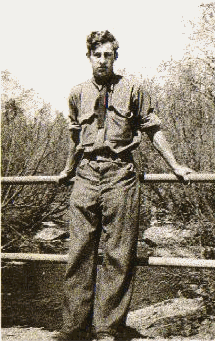 This is a
picture of a young man who worked for the CCC. The CCC camps operated in a
fashion similar to the military. For example, the men had to enlist and go
through a condensed "boot camp." Moreover, they were subjected to
military like discipline. Fort Dix was a typical place for their training. The
training was not severe, but intense, which served the purpose. The men belonged
to companies, similar to the army. These companies reported to sub-districts,
which reported to District Headquarters.
This is a
picture of a young man who worked for the CCC. The CCC camps operated in a
fashion similar to the military. For example, the men had to enlist and go
through a condensed "boot camp." Moreover, they were subjected to
military like discipline. Fort Dix was a typical place for their training. The
training was not severe, but intense, which served the purpose. The men belonged
to companies, similar to the army. These companies reported to sub-districts,
which reported to District Headquarters.
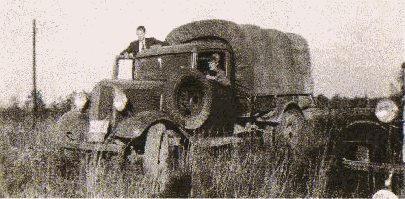 The
equipment used at the CCC camps was military equipment. The men traveled to and
from work projects by using trucks used for soldier transportation. The CCC
system was dictated and ran by Colonels, Majors, Captains, and Lieutenants who
had fought in the previous war. High-ranking officers were brought in from every
branch to oversee and organize this program. The workers were usually dressed in
a uniform that resembled military fashion.
The
equipment used at the CCC camps was military equipment. The men traveled to and
from work projects by using trucks used for soldier transportation. The CCC
system was dictated and ran by Colonels, Majors, Captains, and Lieutenants who
had fought in the previous war. High-ranking officers were brought in from every
branch to oversee and organize this program. The workers were usually dressed in
a uniform that resembled military fashion.
Despite military
aspects, the CCC was still unique in several ways: 1) Most of the people who
worked at the CCC camps were very young, 17-25 years of age; 2) They served like
as non-commissioned officers; 3) The camps provided teachers who taught these
young men academic and vocational skills. The camp operated in a work/school
environment.
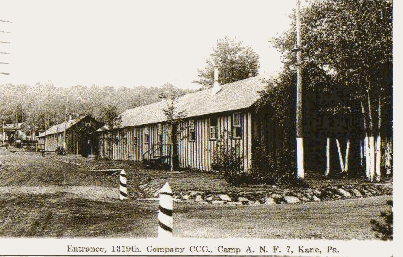 The CCC
workers had to observe military style living quarters and rules. They lived in
"barrack style" houses. They even observed the "lights out"
principal that the military still uses today. Their daily meals were prepared in
the traditional "mess hall." They were led to the mess hall in
"formation" just like the military.
The CCC
workers had to observe military style living quarters and rules. They lived in
"barrack style" houses. They even observed the "lights out"
principal that the military still uses today. Their daily meals were prepared in
the traditional "mess hall." They were led to the mess hall in
"formation" just like the military.
By 1936, the CCC had
improved twelve parks. They built houses, bathrooms, showers, garages, water
systems, and roads. These projects were completed by no less than 200 workers
(the average camp size). The workers were brought in several times to fight
forest fires. This allowed the government to use the National Guard for other
things. Reforestation was the most important of these tasks. Engaging in
significant numbers in erosion control, fire prevention, drought relief, and
reclamation.
Civilian Conservation Corps of Georgia
The Civilian
Conservation Corps equipped Georgia for the future. The road ahead was curvy and
steep, but with the help of the CCC, the roads at least became paved. The work
performed by the CCC created more than a small paycheck. It allowed the existing
economy to take on difficult obstacles sooner than later. All over Georgia,
especially the North, the workers of the CCC cleared land, built roads, and
maintained the land for its natural environment. At the same time the workers
and staff built up relationships. Away from their families, they built trust,
independence, and memories. Building bridges between roads and breaking barriers
among social classes, the CCC made many changes in America. Georgia was included
in these changes in many areas, such as The Cohutta Wilderness, Brasstown Bald,
and Fort Mountain State Park.
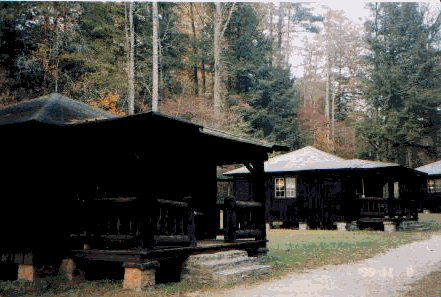 The Chestatee
District is an example of the work produced by four of the thirty-five camps in
Georgia. Nine of these camps were under the direction of the National Forests.
Camp Margret, Suches, and Camp Wahsega are all part of this strong group of CCC
work in America. Company 2417 of the CCC built Camp Wahsega, in Lumpkin County,
in the 1930’s. Established for underprivileged children, now opened to all 4-H
members, the environment was not temporary. The workers settled in for a long
haul and made the most of their stay.
The Chestatee
District is an example of the work produced by four of the thirty-five camps in
Georgia. Nine of these camps were under the direction of the National Forests.
Camp Margret, Suches, and Camp Wahsega are all part of this strong group of CCC
work in America. Company 2417 of the CCC built Camp Wahsega, in Lumpkin County,
in the 1930’s. Established for underprivileged children, now opened to all 4-H
members, the environment was not temporary. The workers settled in for a long
haul and made the most of their stay.

The production of the
"Ward Creek Veterans News" was a local newspaper produced by company
2417. The newspaper included daily issues with lots of humor, ads, classifieds,
and plenty of open comments. The issues had personal columns by the workers. The
papers sold for 10cents each and circulated among the citizens of Dahlonega. The
campers had a chance to voice their opinion and experiences.
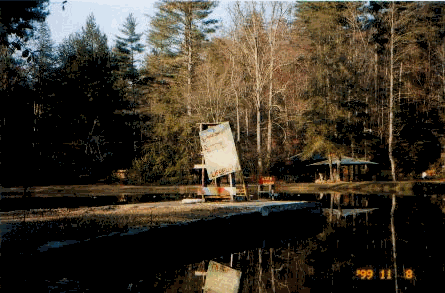
Lake Winfield Scott
creates a "Nature" environment for swimming, hiking, camping, and
fishing. Along with the natural environment, the CCC workers established a rock
and cedar building for shelter. The camp is not the only one in Georgia to be
enjoyed by visitors. Others are Camp Lake Raburn, Camp Rieley, and Camp Woody.
Clyne Woody of
Dahlonega started with the forest service in 1928 as a water boy at one dollar
per day. Since that time, he has served in seven states in many capacities, from
project manager of the old CCC Camp days, to district ranger, to forest engineer
supervising the construction of many roads and improvements that will serve as a
reminder of his work.
A Few Facts about the CCC:
·
In
Michigan, between 1933 and 1944, the young CCC workers planted 484 million
trees, fought forest fires for an amazing 140, 000 days, built 222 buildings,
laid 7,000 miles of railroad track, and managed to construct 504 bridges. Many
of these constructions are still used today.
·
Each
worker earned $30 per month where $25 was automatically sent to the family.
·
Around 63
camps were operating per year during the program. The government paid more
$108.9 million annually. Even today, this would be financially impossible, even
in America’s economy.
·
This
program was to employ only 250,000 people; however, the program, by early 1933,
employed 13.6 million.
·
At the
program’s end, over 500 CCC camps thrived and operated.
·
The CCC
was made up of 250,000 veterans of WWI, 90,000 American Indians, around 3
million young gentlemen, and a number of staff members, government officials,
and volunteers.
A Few Websites on the CCC:
·
http://newdeal.feri.org/
·
http://www.cccalumni.org/
Content
Review Questions:
1)
Besides conserving the land, what other conservation goal was the CCC attempting
to achieve?
2)
What ethnic group was represented more than others in the CCC?
3)
The CCC was run like a branch of the military and therefore led by whom?
4)
How much did the three-and-a-half million men receive a month for their work in
the CCC ?
Content
Review Answers:
1) Conserving the "morale" of the working age population who had
no other prospects of employment in the early 1930s due to the Great Depression.
2) There was no over-representation because it drew from African-American as
well as Anglo-American in the same proportions as the general population at the
time.
3) Veterans of the previous last war, the First World War, were often the
leaders of the CCC.
4) 30 dollars a month, but 25 of it was sent directly home to their families.
Global
Connections Questions:
1)
Given the fact that other countries in the world were hit even harder by the
Great Depression than the U.S., what sort of political/economic responses did
leadership make to keep the peace and keep people from starving, looting, and
stealing?
Global
Connections Answers:
1) Military dictatorship and fascist ideology (based on the all-for-one
race-nation concept: in Germany it was the Aryan Nation; in Japan it was the
Yamato Nation. Russia had Socialism.
Research
Activities:
1)
Research the economic situation in industrialized nations during the Great
Depression. What countries had the highest levels of unemployment and inflation?
What did they do in response to these challenges? Debate as a class whether or
not their actions were justifiable? What could have been done internationally to
alleviate the need for such drastic measures in these countries?
2)
In America, what other New Deal programs saved the country from the chaos and
militaristic responses that were occurring in other countries? How many of these
programs are still in existence today? Create a chart and present your findings
to class.
 This is a
picture of a young man who worked for the CCC. The CCC camps operated in a
fashion similar to the military. For example, the men had to enlist and go
through a condensed "boot camp." Moreover, they were subjected to
military like discipline. Fort Dix was a typical place for their training. The
training was not severe, but intense, which served the purpose. The men belonged
to companies, similar to the army. These companies reported to sub-districts,
which reported to District Headquarters.
This is a
picture of a young man who worked for the CCC. The CCC camps operated in a
fashion similar to the military. For example, the men had to enlist and go
through a condensed "boot camp." Moreover, they were subjected to
military like discipline. Fort Dix was a typical place for their training. The
training was not severe, but intense, which served the purpose. The men belonged
to companies, similar to the army. These companies reported to sub-districts,
which reported to District Headquarters. The
equipment used at the CCC camps was military equipment. The men traveled to and
from work projects by using trucks used for soldier transportation. The CCC
system was dictated and ran by Colonels, Majors, Captains, and Lieutenants who
had fought in the previous war. High-ranking officers were brought in from every
branch to oversee and organize this program. The workers were usually dressed in
a uniform that resembled military fashion.
The
equipment used at the CCC camps was military equipment. The men traveled to and
from work projects by using trucks used for soldier transportation. The CCC
system was dictated and ran by Colonels, Majors, Captains, and Lieutenants who
had fought in the previous war. High-ranking officers were brought in from every
branch to oversee and organize this program. The workers were usually dressed in
a uniform that resembled military fashion. The CCC
workers had to observe military style living quarters and rules. They lived in
"barrack style" houses. They even observed the "lights out"
principal that the military still uses today. Their daily meals were prepared in
the traditional "mess hall." They were led to the mess hall in
"formation" just like the military.
The CCC
workers had to observe military style living quarters and rules. They lived in
"barrack style" houses. They even observed the "lights out"
principal that the military still uses today. Their daily meals were prepared in
the traditional "mess hall." They were led to the mess hall in
"formation" just like the military. The Chestatee
District is an example of the work produced by four of the thirty-five camps in
Georgia. Nine of these camps were under the direction of the National Forests.
Camp Margret, Suches, and Camp Wahsega are all part of this strong group of CCC
work in America. Company 2417 of the CCC built Camp Wahsega, in Lumpkin County,
in the 1930’s. Established for underprivileged children, now opened to all 4-H
members, the environment was not temporary. The workers settled in for a long
haul and made the most of their stay.
The Chestatee
District is an example of the work produced by four of the thirty-five camps in
Georgia. Nine of these camps were under the direction of the National Forests.
Camp Margret, Suches, and Camp Wahsega are all part of this strong group of CCC
work in America. Company 2417 of the CCC built Camp Wahsega, in Lumpkin County,
in the 1930’s. Established for underprivileged children, now opened to all 4-H
members, the environment was not temporary. The workers settled in for a long
haul and made the most of their stay.
